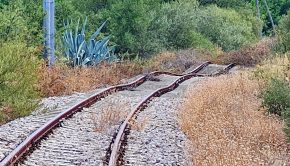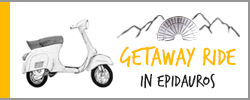Getaway ride in Epidauros: Music, plants and the best bread in the region
Tiny Ligourio is the central village in the community of Epidauros. Having less than 3000 inhabitants it can’t provide employment to all. Many of the ligourians commute between their homes and the coastal town of Nafplio, former capital of Greece. It is only a 25-minute-drive away. One of the commuters is musician Gerlinde Katsoulieris. Another agronomist Vasilis Petris, but in the opposite direction: his home is in Nafplio, shop in Ligourio. And then we have young Alexandra Kostopoulos who has her familybakery in Adami, Epidauros, and a cafe-bakery in Nafplio… Said to produce the absolutely best bread in the region. Let’s ride with them from Ligourio to Nafplio and back – listen, see and taste some new wonders of Epidauros!
*** *** ***
Text and pictures copyright Horsemail.fi / Margit Ticklen. No reproduction allowed.
First tip: how to get to know a musician in a small village like Ligourio? For me it happened easily.
I was to quit the region after my first two-week stay in summer 2021. To thank my friend about her time and devotement to show me the region I asked the people I had to get to know during our walks in Epidauros area (link) if they knew a musician for a surprise to a friend. The surprise was to be a small, private concert on top of the hill behind the old part of Ligourio, by the small church of Taxiarchon.
That’s how the name and telephone number of Gerlinde Katsoulieris were given to me. “She plays flute and gives lessons of it in Nafplio. She is really good”, I was told.
It was a hot-hot midday when I met Katsoulieris – in secret from my friend – to plan the surprise. Walking up to the Taxiarchon church the musician told me she liked all kinds of classical music.
“I would prefer to play three smaller pieces to your friend. Different kinds of pieces by Stamitz, Telemann, Hoover. She certainly likes ta least one of them”, Katsoulieris suggested.
I nogged as I would understand something about the names mentioned. Truth was I had never heard any flute music from these three composers!
I listen to classical music but mostly big orchestral works like the symphonies of Sibelius.

Golden Muramatsu!
Katsoulieris knew Sibelius, of course, but stated she was nearly sure Sibelius had not written any music for a solo flute. I left the decision about the actual music being played during the surprise to her.
That was a correct step. The surprise was a big success.
Taxiarchon, which you see in the opening picture of this article, is a place where one hardly ever meets anyone. Only one’s own thoughts, the sheep and the wind are present.
The evening of the surprise, walking to the church, my friend first thought she had become mad when she understood she heard flute music approaching the Taxiarchon.
And yes, there was flute music. Music played with a golden Muramatsu!
I had thought flutes were made of wood. In a classical big orchestra the flute is part of the woodwind section. Like bassoon, clarinet and oboe.
“No, they can be made of many different metals, too. According to the metal one gets different kind of sound out of them”, Katsoulieris told me.
What she didn’t tell me was the price of a golden Muramatsu. I found it in internet: from 10 000 to 60 0000 euros, depending on the karats of gold used.

Travels to Germany for concerts
I also got to know Katsoulieris is born in Austria and raised up in Germany. She has lived more than 25 years in Greece. Out of them 14 in Ligourio.
“At first I had to work as a music teatcher in the city of Argos. Slowly I got more and more students from Ligourio. Until they became again less… Then my main focus moved from Ligourio to the Odeion of Nafplio. Now I teach in Nafplio three evenings every week”, Katsoulieris told me.
She loves Greece. Despite the fact that her marriage with a Greek came to an end 15 years ago, in 2006.
“I love nature here, I love Greek food. I also loved to play chamber music with other musicians when we still were four musicians teaching in Nafplio. Unfortunately one of us was from Switzerland and returned there a few years ago. Another one was from Kazakstan and returned there… Except me only one Greek pianist is left in the region. Two musicians can’t make a chamber orchestra.”
This means Katsoulieris has to fly to Germany to play in concerts.
“Yes. I exercise here in Ligourio on my own. Right now I prepare myself for a concert that will be given in Freiburg, Germany on 22nd of January 2022”, Katsoulieris explained.
The old road to Nafplio
I was impressed by Katsoulieris’ discipline and determination. I got even more impressed when I hopped one afternoon on her car and drove with her to Nafplio. Our target was her working place in the building of the old main railway station of the town.
Katsoulieris didn’t drive to Nafplio by the new national road. She prefers the old one. It is more or less like a 25-kilometre-long serpentine (link/video) between Ligourio and Nafplio.
“I like the fact I have the olive trees only a few meters from me. Driving on the old road I feel like inside an olive grove all the time”, Katsoulieris said.
The old road goes through the village of Arkadiko. Getaway ride in Epidauros already once visited the village when going up to the Mycenean acropolis of Kazarma (link).
The amazing thing about this way to Nafplio is that even without going out of the car one ends up to only some meters of great remines of the Mycenean culture.
First of all one passes the circular shaft grave in Arkadiko, then the arch bridge of Kazarma (link/video). Both of them are said to be about 3200-3500 years old.


Music and human mind…
Arriving to Nafplio by car required about 25 minutes. We talked about- music and its impact on human brain.
“The psychological effects of music can be very powerful. Music therapy is often used to promote emotional health, helping to cope with stress. To boost psychological well-being in general”, Katsoulieris reminded.
I had heard similar things before. Without no exact proofs I told Katsoulieris I remembered having read about some researchers suggesting our taste in music could provide insight into our personalities.
“I keep in my mind the impression that those who are open to new experiences, who display imagination and are intellectually curious tend to prefer classical music… Maybe blues and jazz, too”, I said.
Katsoulieris laughed at me.
“Oh, that would be a nice conclusion to me as a teatcher of classical music. But I don’t know if that is correct. In my eyes classical music lovers are typically more introverted… Perhaps one could say they are quite well at ease with themselves and the world around them? At least my students, in general, have a good sense of self-esteem”, Katsoulieris analysed.
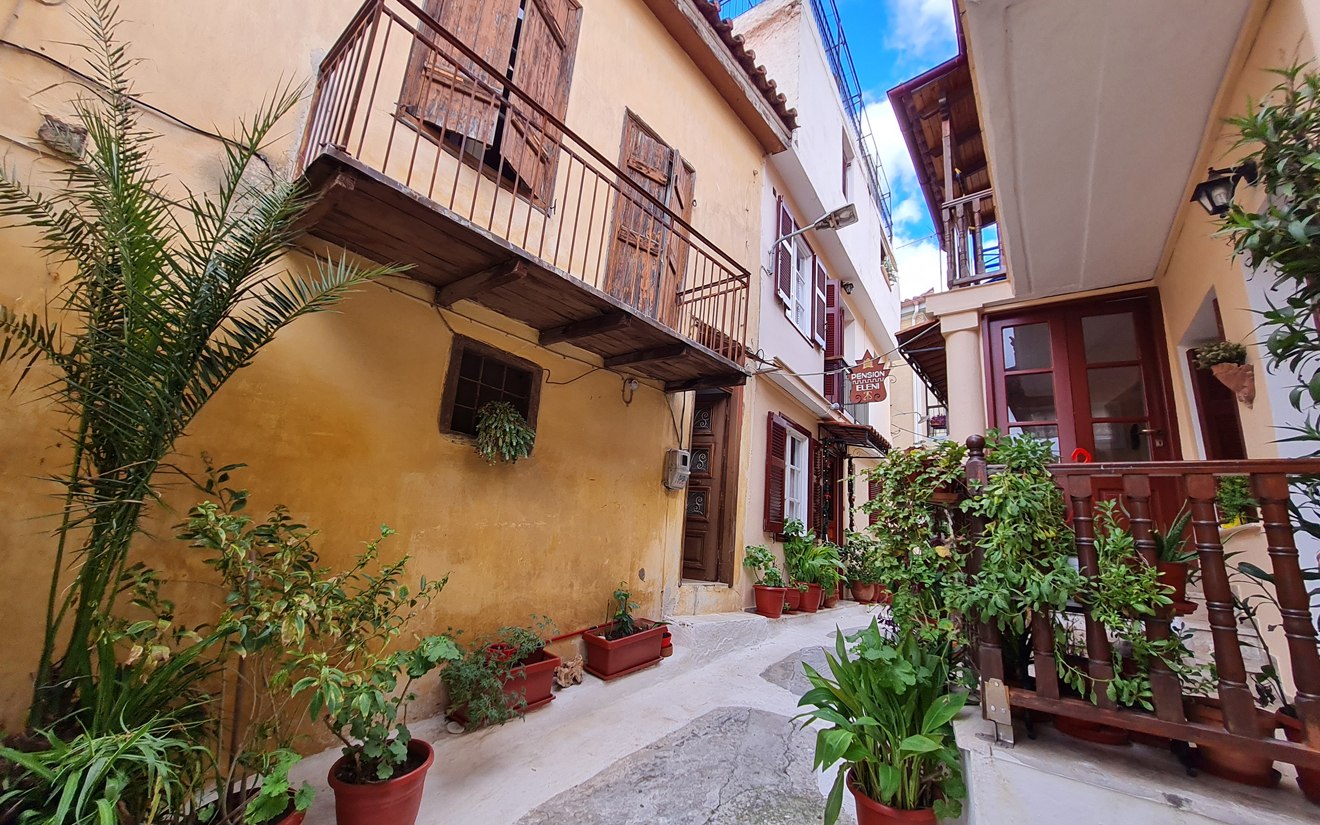
Old town 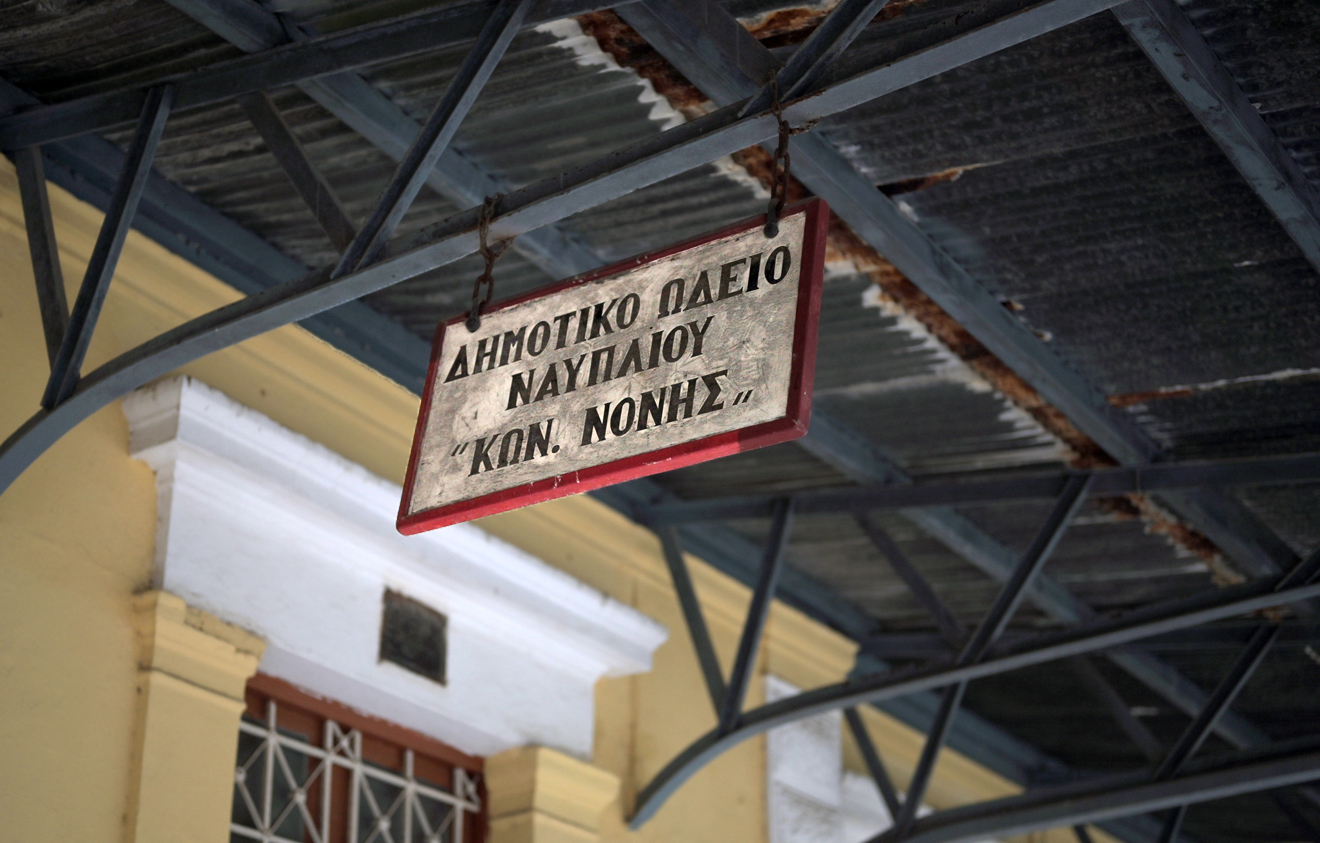
Odeion 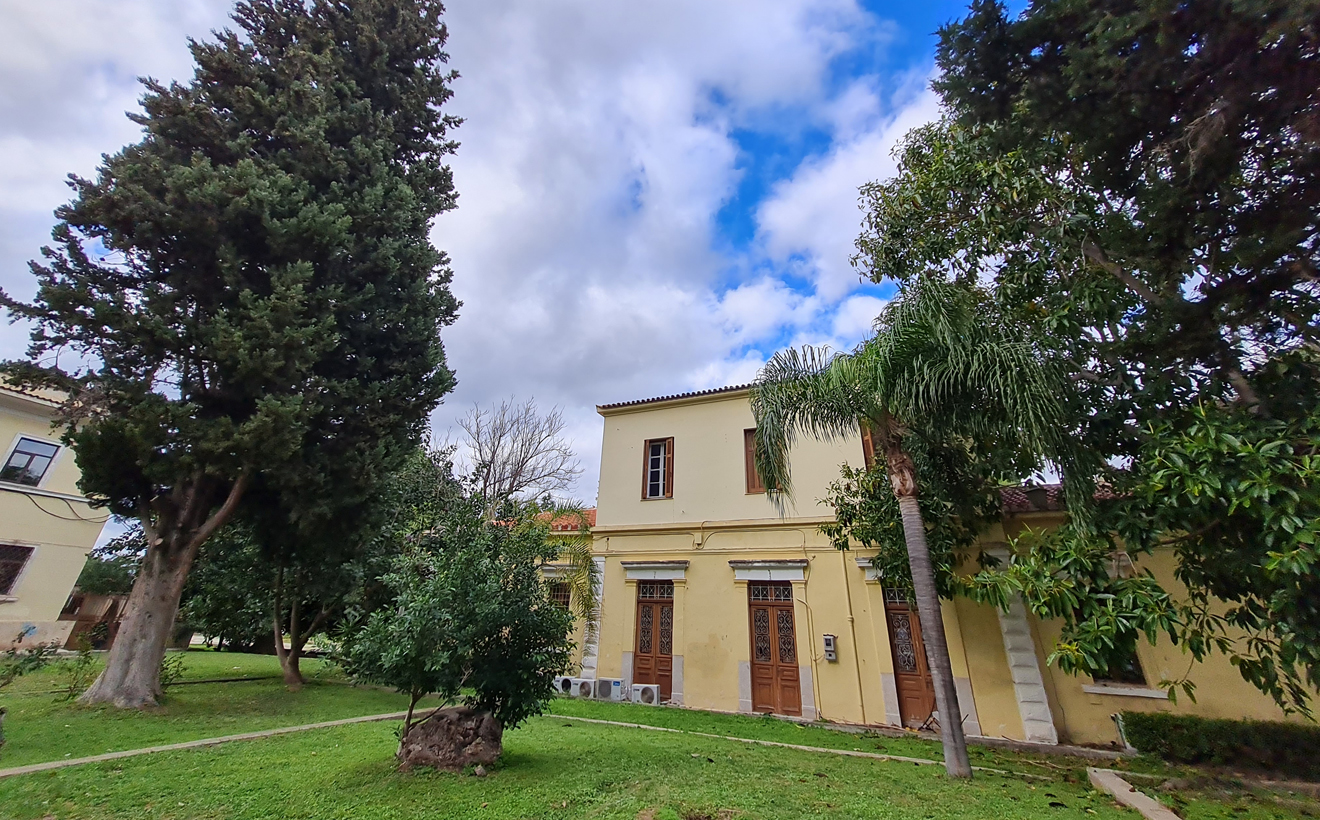
Odeion 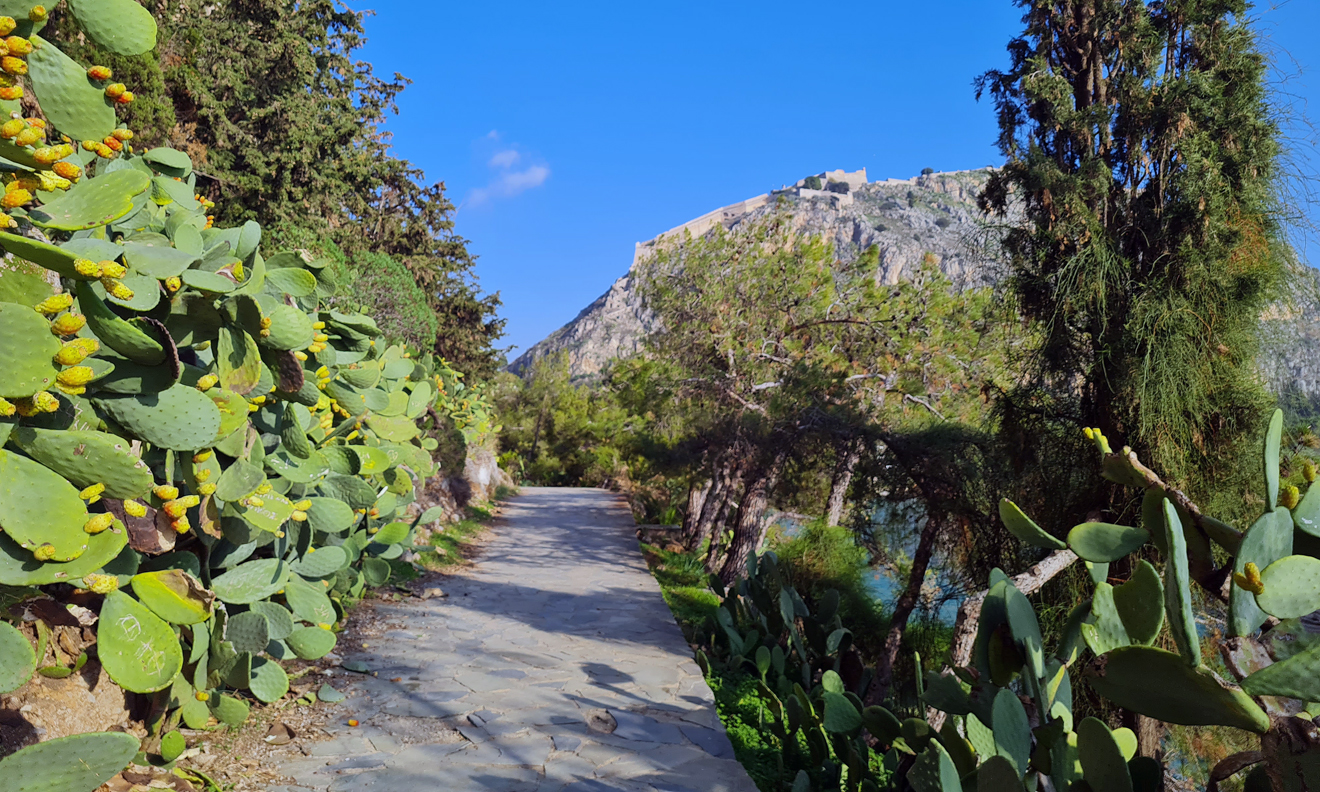
Palamida 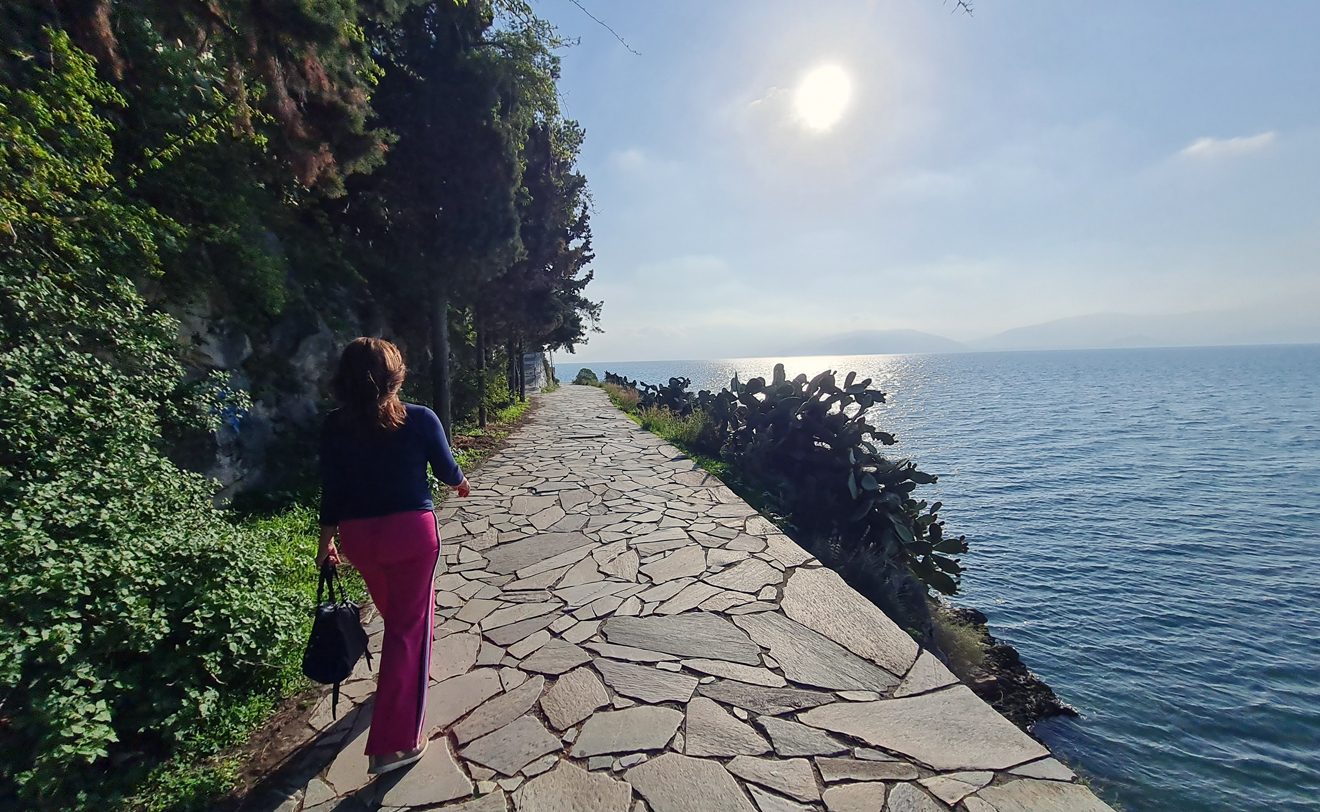
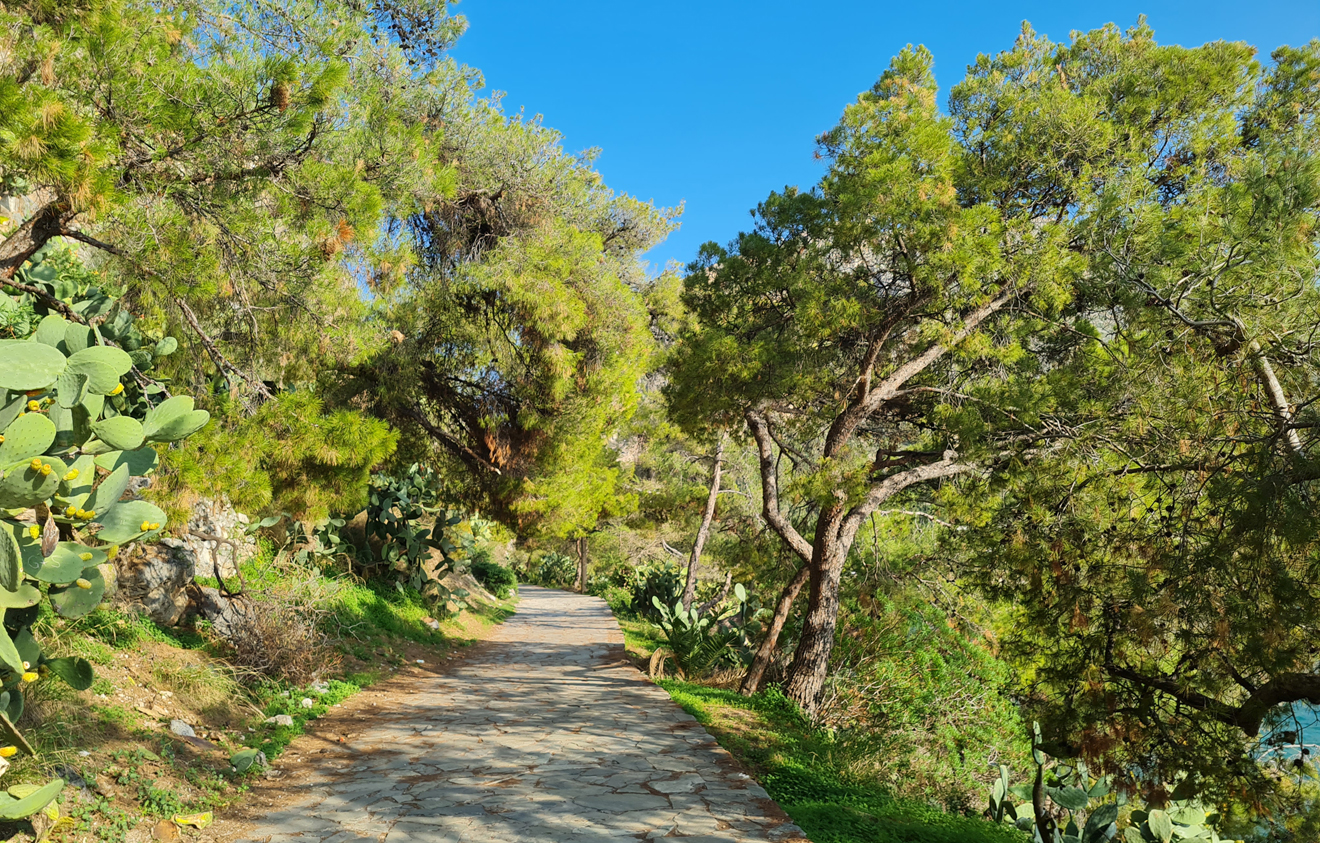

Fortress of Bourtzi
Eucalyptus trees and abricots
In Nafplio I left Katsoulieris to work with her students in Odeion. Another guide was waiting for me: Vasilis Petris. Petris is an agronomist and photographer I had got to know during one of my walks in Epidauros with the Pezoporiki Omada Ligouriou.
He stayed in my mind from the first meeting. For a special reason. I didn’t immediately understand his profession – the greek word geoponos, agronomist, was unknown to me. Returning from the walk I boasted my friend I had met a giatros tis gis, a doctor of soil!
Petris lives in Nafplio but has a shop selling agricultural stuff in Ligourio. He drives the way from Nafplio to Ligourio and back every day.
In Nafplio he has his family. In the city itself he likes the most its swimming pools, gyms and cafes.
I decided to have a look at the cafes with Petris. But before that I wanted to know about the vegetation in the region of Epidauros. I have always been thinking the green colour of the plants and trees is more than important to our mental health. More important than music.
In my surprise Petris didn’t talk to me about the pine tree forests. He talked about the different citrus trees.
“There are olive trees all around, of course, but we have also various kind of citrus trees. In Epidauros there are some famous farms producing abricots. And pomegranates… Then we have wild figue trees”, Petris counted.
With slightly less enthousiasm he added the eucalyptus and oleander trees.
“They are not native Greek trees. They are imported from Australia and only well rooted here. Like the callistemon and lantana bushes”, Petris said.

From the realism of the streets to the surrealism of the clouds
The fact I have had quite a lot to do with Petris lies first in him being an agronomist. My friend, with whom I stayed most of the autumn 2021 in Ligourio, had a nice but somewhat empty garden. I asked Petris to come and give advice about the trees and bushes to be planted there.
The good news is Petris has also a substantial knowlegde of photography. The pictures on the first page of Getaway ride in Epidauros (link) with the Piaggio-scooter are by him.
Petris started photography as a stress-relieving hobby some years ago.
“I have 3-4 cameras that I use. All of them made by Sony. At first I took pictures about nearly everything. More seriously I have been interested in picturing the naked body and making street photography”, Petris reflected.
Street photography is a world apart.
“Normally, when you go somewhere to shoot, you have in your mind something you would like to capture. In street photography everything relies on your chance. You are like a hunter: you will shoot what you happen to see”, Petris explains.
I am happy to hear this. Of course, because my heroines in photography are called Vivian Meier, Laetizia Battaglia, Henri Cartier-Bresson. Irmeli Jung.
Jung, as retired person, has started to take pictures of the waves of the Mediterrannean sea. Petris, instead, has lately turned his eyes in the sky.
“For a while I took pictures of the Milky way. That is only possible here during the summer months. So I continued to use the tripod technique to the clouds. When using a shutter speed of 20 seconds or more one can catch their movement in an interesting, surrealistic way”, Petris reasons.

Best cafeterias in Nafplio?
After plants and photography we got to our true reason of meeting in Nafplio: the cafés. Petris first took me to one of his favourites, the Mavros Gatos (link) nearby the port.
“Most of the cafeterias in Greece serve as well cafe and other non-alcoholic drinks as well as alcohol. There are some big, mostly foreign branches like Starbucks or Miguel that are an exception to this. For exemple here, in Mavros Gatos, you can order anything you like”, Petris tells me.
He then gives me a list of the cafes he likes to visit in Nafplio.
“There is Rosso and there is Sokaki, both in the very center of the town and close to each other. Then there is Plektirio and Bicycle. Bicycle is a bit outside of the center, towards Argos”, Petris points out.
The ones I have seen and been into are not on the list of Petris. Kontrabasso nearby the beginning of the 999-step-stairway to Palamidi, the fortress dominating the skyline of Nafplio. Stathmos, the cafe at the old station building of Nafplio, and the cafe-bakery Kostopoulos.
Kostopoulos lies by the street leading from Nafplio to Karathonas beach. If you take that road very soon you have left Nafplio behind you will see, climbing steeply uphill with your car, three gingko biloba trees on your left.
Who would have believed there are gingko bilobas, the sacred trees of the eastern cultures, in Nafplio…?

Bread from Nafplio & Adami
Kostopoulos’ cafe is of special interest for us. It is a family business originally started in 1978 in Adami, a village of Epidauros.
Adami was the first place I got to know outside of Ligourio when I arrived to Epidauros in July 2021. It is famous for two things: there are restaurants making josa, a special meal from the meat of an older goat, and the Kostopoulos bakery.
Kostopoulos bakery is worth of a drive. By foot it is a bit too far away from Ligourio – about seven kilometres of which most uphill.
It is worth of a drive especially if you like “brown bread” made of something else than wheat. Kostopoulos bakery has several varieties of brown bread. With different seeds on top of them – or plain, completely without. As you like.
When we get to Kostopoulos bakery in Adami the whole family is busy preparing the Christmas breads.
The whole family means mother Sofia Kostopoulos (pictured below) and her four children Alexandra, Konstantina, Irini and Giorgos. Their father, who started the business over 40 years ago, has unfortunately already passed away.

Do like the ancient Greeks: dip it!
I don’t know much about the habits of eating bread in Greece. I just remember, from my studies in classical archaeology at the University of Helsinki, that in ancient Greece the Greeks started their days by dipping a barley bread in wine. With the bread they might have eaten some figs or olives…
Nowadays I have seen most of the Greeks taking in the morning only a (small) cup of strong coffee. Sometimes a piece of white bread topped with butter or marmelade.
As a Finn I am not so familier eating the white bread. The most notorious bread in the North is not called brown bread but black bread. It is made of rye, not wheat.
So it’s no wonder I prefer even in Greece breads that have more taste than the general village style white bread: namely the skorthopsomo and eliopsomo.
Skorthopsomo is a garlic bread made with fresh garlic. Most bakeries mix the garlic with butter to spread it onto the bread.
Eliopsomo is a bread made with flour, water, yeast, salt, black olives, and flavorings like honey and rosemary. The bread can well be used for dipping it into a combination of olive oil, oregano, salt, and pepper.
That’s how you get inside of you a vibrating feeling of continuing the ancient Greek tradition… Especially in the wonderful green surroundings of Epidauros.

One sweet variety? Try koulouri
In the bakery of the Kostopoulos family I have to taste several products. At the end I decide to take a cappuccino, too, to accompany some sweeter tasting. It is called koulouri.
There are plenty of different kinds of kouluri in Greece. I take one of Kostopoulos’ with orange flavour.
“Kouluri is a traditional Greek street food staple. It is especially famous in Thessaloniki. It probably originally was a concept similar to simit, a circular bread found in Turkey.
We make the kouluri mostly with wheat flour dough. The dough is shaped into a ring and then coated with sesame seeds, for exemple”, Alexandra Kostopoulos explains.
After tasting the kouluri we need to return to Ligourio. It has taken me the whole day to cover a distance of about 60 kilometres.
The route, which I have called the commuters’ route, went in the morning from Ligourio to Arkadiko and Nafplio. In the afternoon we came back from Nafplio to Ligourio via the village of Adami. Stomachs full, ready to go to bed!

*** *** ***
Text and pictures copyright Horsemail.fi / Margit Ticklen. No reproduction allowed.
GETAWAY RIDE IN EPIDAUROS (link / first page)
1) WALKS NEARBY LIGOURIO
– OLIVE GROVES AT THE THEATRE (link)
2) PLACES & HISTORY:
– THE WALLS OF THE MYCENAEAN FORTRESS OF KAZARMA (link)
PRACTICAL INFORMATION:
– TO TAKE A TAXI in Ligourio
call +306936800445 (Georgios)
– TO STAY AT A HOTEL at the theatre
call +306988026060 (Avaton)
– TO EAT in Ligourio
call +302753022072 (T’Asteria)
– TO BUY bread in Adami or Nafplio
click here (Kostopoulos)
– TO SEE THE EXACT METEO for Ligourio
click here (Sokratis Ksipolias)













